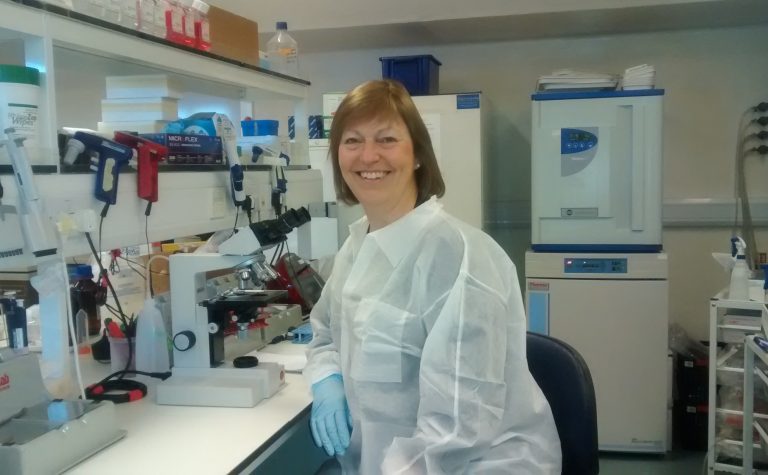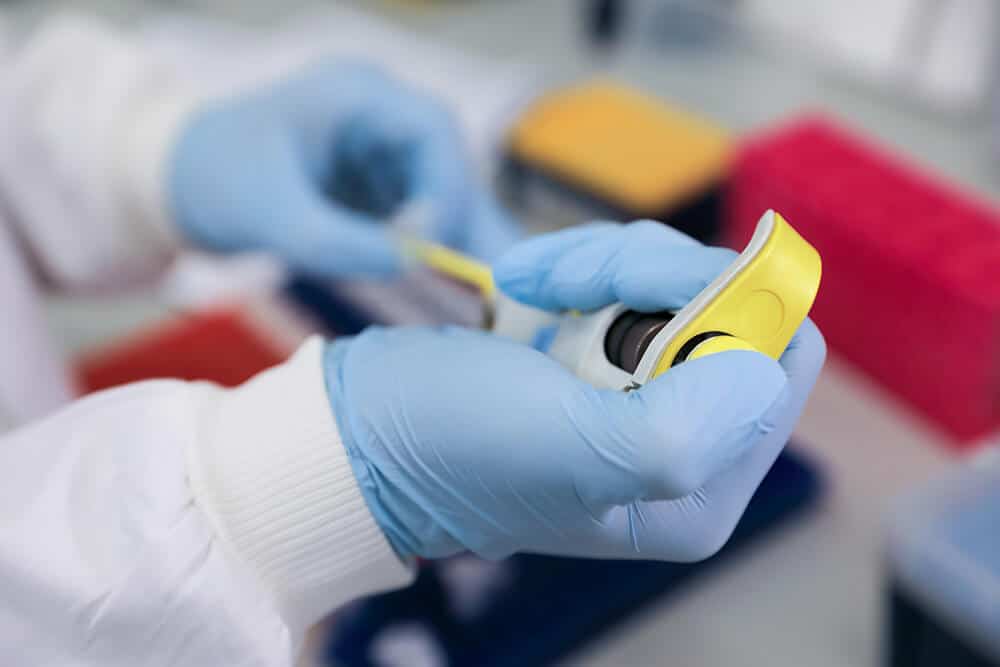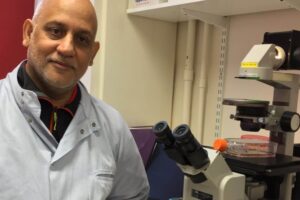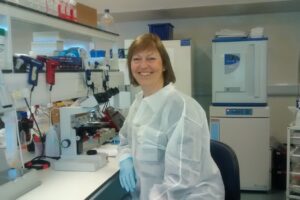Research
Can a simple blood test speed up diagnosis of Hodgkin lymphoma?
Hodgkin lymphoma is one of the most common cancers affecting children and young adults. Although the cure rate is high, it’s easily mistaken for other diseases, like glandular fever. Finding a simple way to diagnose it earlier would help children avoid unnecessary illness, and maybe mean less intensive treatment. This project is looking at how a new blood test could help.
Because cancers are rare in children, and Hodgkin lymphoma usually shows as lumps in the neck with more general symptoms like tiredness and night sweats, doctors often think it’s something common like glandular fever. A new blood test for this type of cancer could make diagnosis easier.

Project Details
- Evaluation of CCL17 as a diagnostic biomarker for classical Hodgkin lymphoma
- Lead Researcher
- Professor Ruth Jarrett
- Research Centre
- University of Glasgow Garscube Estate
- City & Institution Postcode
- Glasgow, G61 1QH
- Start Date
- 1 October 2016
- Project Duration
- 32 months
- Grant Amount
- £149,968
Overview
Lymphoma is a form of blood cancer affecting the same cells as leukaemia but in lymph nodes rather than bone marrow. Cancerous cells cluster in the lymph nodes and form solid tumours. They can also spill into the blood stream and spread the cancer around the body. Hodgkin lymphoma usually affects the lymph nodes in the head and neck, and non-Hodgkin lymphoma can affect any lymph node in the body. It’s one of the most common cancers in children, teenagers and young adults, with around 340 cases of Hodgkin lymphoma every year in the UK, mostly affecting children older than 10. Blood samples from people with untreated Hodgkin lymphoma usually contain high levels of a molecule called CCL17. So it’s possible that a simple lymphoma blood test could be used to distinguish it from more common diseases like glandular fever. Then we could refer children more quickly for treatment. We don’t yet know enough about CCL17 levels in other diseases. So before we can use this test to screen for Hodgkin lymphoma, we need to learn more and see whether the test can pick out children with Hodgkin lymphoma from others with similar symptoms.
What difference will this project make?
The study may lead to a blood test that will help diagnose Hodgkin lymphoma. Many people with this cancer have tests for glandular fever or other simple blood tests first, and hospital referral is only arranged once doctors realise they’re dealing with some more serious. If we could test at the same time as glandular fever testing, children with this disease could get treatment more quickly. The team will measure CCL17 levels in 100 to 150 samples using a test that’s been extensively used in Ruth’s laboratory. First, they’ll test people who doctors think have Hodgkin lymphoma to see whether the CCL17 test can correctly identify those who actually have the disease. Then they’ll test a random selection of around 1,000 blood samples from younger and older children being screened for other things. This will help show whether raised CCL17 levels are found in other diseases. Finally, they’ll test 1,000 samples submitted for diagnosis of glandular fever, since some of them might actually come from people with (undiagnosed) Hodgkin lymphoma. If that works, we may be able to start doing CCL17 tests at the same time as glandular fever testing. Hodgkin lymphoma already has a high cure rate, but it’s possible that spotting it sooner, when it’s spread less, could make treatments easier for children that need them.
About the Research Team
Ruth Jarrett is Professor of Molecular Pathology at the University of Glasgow. She is a leading expert in lymphoma in children and young people, and she and her group believe that CCL17 testing has a role at several points in the care pathway. Professor Frank Sullivan and Professor Bruce Guthrie will help to decide whether to start using this test on more children. Mr Omar Hilmi is an ENT surgeon, who’ll be helping to make sure that doctors know about the test so they can refer children who might need it.

Learn more about Burkitt’s lymphoma (BL)
Does lymphoma show up in blood work?
Burkitt’s lymphoma (BL) is a fast-growing form of non-Hodgkin’s lymphoma that usually develops in young children. It starts in a type of white blood cell, called B-cells or “B-lymphocytes”, that normally help to fight infections. There are three known types of BL: an endemic BL variant (eBL) that occurs mostly in Africa, the sporadic variant, which is the most common in the UK, and an immunodeficiency-associated variant that occurs mostly children with HIV. Infection with some types of viruses have been shown to increase a person’s chances of developing cancer, an example being human papillomavirus (HPV) which can cause cervical cancer. It is understood that sporadic BL is associated with infection of the Epstein Barr virus (EBV), and there is some evidence that this virus is also connected to eBL in Africa. In addition, long-term exposure to toxins produced by some moulds, known as “mycotoxins”, have been shown to increase a person’s chances of developing some types of cancer such as hepatocellular carcinoma, the most common type of primary liver cancer. This is a problem because these moulds can grow on staple crops, especially in low- and middle-income countries (LMICs), which also leads to outbreaks of other diseases. A recent study estimated that between 60-80% of world’s food crops are contaminated with mycotoxins, meaning that many populations continue to be exposed to mycotoxins in their diets. The health and economic consequences of mycotoxins is severe in LMICs. Chronic exposure to mycotoxins is associated with higher incidence of BL across regions of Africa, but this link is not well understood. Nor is it known whether mycotoxins could be interacting with EBV to cause cases of eBL. In this Project, Dr Grace Akinyi Odongo will assess the impact of exposure to mycotoxins and EBV infection in the womb and early childhood. Dr Grace Akinyi Odongo will also examine how gene activity is altered in BL cancer cells. In healthy cells, genes can be “switched on” or “switched off” over time depending upon their job. Making sure that the right genes are switched on or switched off at the right time is essential for normal cell functioning. It’s increasingly understood that many diseases are caused by or associated with genes behaving incorrectly.
Thank you
This research project on looking at how a blood test can help with diagnosing Hodgkin lymphoma has been successfully completed. Your donations allow us to fund ground-breaking research that can improve treatments given to children with cancer. Thank you. Your help allows us to continue to find ways to drive up the chances of survival for children with cancer and reduce the toxic side effects that can affect the rest of their lives.
Other stories
We have lots of information to help you learn more about childhood cancer. From specific cancer types, to treatments and causes.






